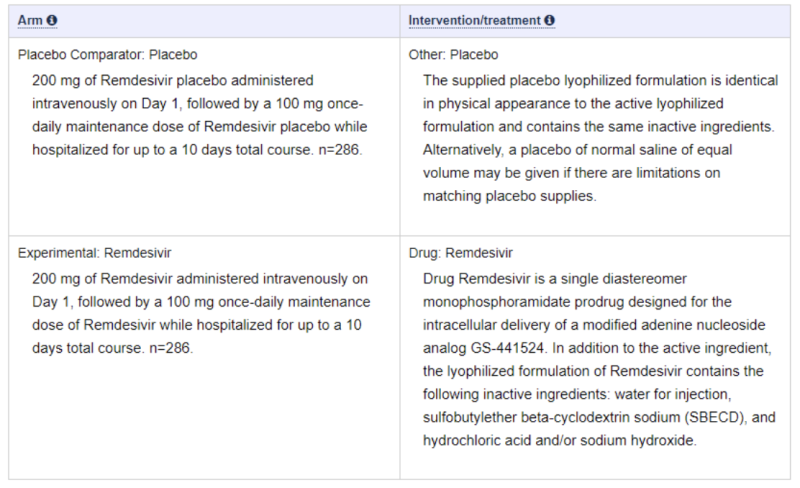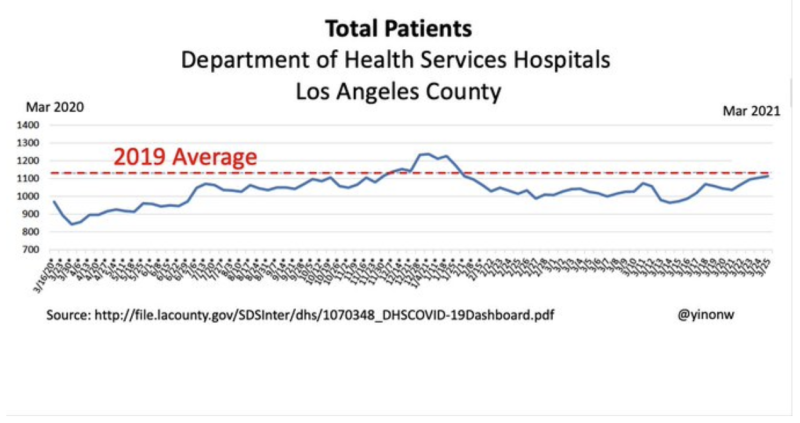[The following is a chapter of Lori Weintz’s book, Mechanisms of Harm: Medicine in the Time of Covid-19.]
Tragically, the government-backed mechanical (ventilators) and pharmaceutical (remdesivir, mRNA shots, etc) interventions didn’t work to remedy the respiratory illness problem. Instead, they added an additional layer of chaos on top of the virus mania that had captured the world.
Jordan Schachtel
Investigative journalist
December 13, 2023
In the interview with Zuckerberg, in addition to mentioning HCQ, Fauci said, “There’s a drug called remdesivir, which is…developed by Gilead as an antiviral. We tried it in Ebola. It didn’t work as well as some of the other drugs, but it’s there.” It was really, really there; remdesivir manufacturer Gilead spent $2.45 million lobbying Congress in the first quarter of 2020, which was also when Congress drafted and passed the Coronavirus Aid, Relief and Economic Security (CARES) Act that included funding for vaccines and treatments in response to the pandemic.
Remdesivir was Removed from the Ebola Trial Because of Toxic Effects:
“Didn’t work as well” was a gross understatement. During the 2018 Ebola drug trials funded by the National Institutes of Health (NIH), remdesivir (brand name Veklury) was one of four different drugs used to treat Ebola. Those in the remdesivir group had the highest overall deaths, with a mortality rate of over 50 percent in the first 28 days. Trial participants who received remdesivir also had significantly elevated markers for liver and kidney damage, leading the safety board to terminate its use mid-trial.
A drug with remdesivir’s profile was not a good candidate for much of anything. It’s not that it just wasn’t effective against Ebola; it’s toxic. Why would Fauci even consider it?
Robert F. Kennedy, Jr explains one reason in his book The Real Anthony Fauci (TRAF). It has to do with perception. The NIH had to appear to be doing something about the pandemic in the short term, even though the long-term goal was the vaccine. RFK, Jr states:
“Optics required that NIH devote some resources to antiviral therapeutic drugs; critics would complain if [Fauci] spent billions on vaccines and nothing on therapeutics. However any licensed, repurposed antiviral that was effective against Covid for prevention or early treatment…could kill his entire vaccine program because FDA wouldn’t be able to grant his jabs Emergency Use Authorization. Remdesivir, however, was an IV remedy, appropriate only for use on hospitalized patients in the late stages of illness. It would therefore not compete with vaccines.” (TRAF p. 64 emphasis added)
National Institutes of Health Employees Profit from Drug Patents:
The fact that the FDA’s advisory committee, the Vaccines and Related Biological Products Advisory Committee (VRBPAC), the one that met today and voted to recommend to the FDA to grant the EUA (for the Covid-19 vaccines) that’s really important…because what it shows is that the process that we have here in the United States is, decisions and recommendations are made by independent bodies…we want to make sure that we impress the American public that decisions that involve their health and safety are made outside of the realm of politics, outside of the realm of self-aggrandizement, and are made, in essence, by independent groups.
Dr. Anthony Fauci
Director NIAID
December 11, 2020
Dr. Fauci states that decisions involving American’s health and safety are made “outside of the realm of politics,” but nothing could be further from the truth. The other reason RFK, Jr. gives for Fauci’s interest in remdesivir is money. National Institutes of Health (NIH) employees are allowed to put their name on patents, and thereby profit from product approval. For example, NIH is listed on the patent for Moderna. Tellingly, Anthony Fauci’s household net worth increased during the pandemic from $7.5 million to $12.6 million.
In addition to the conflict of interest at NIH, with employees profiting from products they approve, a large portion of the operating budget for NIH, which includes agencies such as the Food and Drug Administration (FDA), is provided by pharmaceutical companies – the very companies whose products the FDA regulates. In short, there was money to be had in remdesivir, and none to be had by using already approved medicines that were no longer under patent restrictions, and therefore inexpensive.
Investigative journalist Sharyl Attkisson found that at the time of the remdesivir review, eleven members of the NIH’s Covid-19 Treatment Guidelines panel had financial ties to Gilead. A review of the panel members during the past year finds myriad relationships between NIH panel members and various drug companies. Gilead, flush with the prospect of remdesivir becoming the treatment for Covid, predicted remdesivir would bring in $3.5 billion in 2020 alone.
In April 2020, knowing remdesivir’s dismal and dangerous profile, Fauci’s NIAID began the clinical portion of a 29-day remdesivir trial on hospitalized US volunteers. The Protocol Details Summary states that, “The drug has been tested before in people with other diseases,” but neglects to mention its complete failure in the Ebola trial.
The Rise of Remdesivir Despite Poor Performance:
Before Fauci’s remdesivir study was completed, a study conducted in China was released that should have put remdesivir out of the running.
The Chinese study found that intravenous remdesivir:
- did not provide significant clinical or antiviral effects in seriously ill Covid-19 patients,
- was not associated with a difference in time to clinical improvement,
- caused adverse events in 66% of remdesivir recipients
In short, patients were worse off taking remdesivir than if they received the placebo.
RFK, Jr. points out that, “The Chinese study was a randomized, double-blind, placebo-controlled multi-center, peer-reviewed study, published in the world’s premier scientific journal, The Lancet.” “In contrast, Dr. Fauci’s NIAID study was, at that point, still unpublished, not peer-reviewed, its details undisclosed. It employed a dirty placebo and had suffered a sketchy mid-course protocol change,” which is taboo in clinical studies. (When the NIAID study couldn’t show a reduction in disease or mortality, the end goal was changed to a reduced hospital stay.)
A dirty placebo, also known as “spiked,” or “phony” placebo, refers to the use in a drug trial of an “active comparator” rather than a pure placebo such as a saline injection. In this case, patients in the treatment arm were given remdesivir. Patients in the “placebo” arm were given remdesivir that contained the same ingredients, but in an inactivated state. As explained by RFK, Jr., Dr. Fauci’s NIAID has developed the use of “spiked” placebos over 40 years to “conceal adverse side effects of toxic drugs for which they seek approval.” (TRAF p. 65)
Following is a chart from the Arms and Interventions section of the study showing that the NIH study did indeed employ a dirty placebo. As shown on the left, 200 mg of Remdesivir, with some inactive ingredients, was used as the Placebo Comparator, and 200 mg of Remdesivir was used as the Experimental drug. Logic would indicate that determining the effect of a new, unapproved drug would be better served by placing it opposite an actual placebo, instead of opposite a modified version of the same drug.


Dr. Fauci Chooses Remdesivir as the “Standard of Care” in the U.S.:
The NIAID spent upwards of $70 million in taxpayer money in connection with the development of remdesivir to treat Covid-19. It’s a legitimate question to ask why remdesivir was even considered in 2020. It had been pulled from the Ebola trial in 2018, due to elevated markers for liver and kidney damage and a trial participant mortality rate over 50 percent.
Fauci, knowing the Chinese study was about to be published, which would likely impede the FDA’s approval of remdesivir to treat Covid-19, headed off the bad news in an Oval Office press conference on April 21, 2020 declaring “quite good news.” Fauci said the NIAID’s clinical trial showed remdesivir was reducing the hospital stay of infected Covid patients by about four days. He neglected to mention the significant number of adverse events in both arms of the study, and that twice as many remdesivir subjects as placebo subjects had to be readmitted to the hospital after discharge, raising the question of early release to make the numbers look better. Fauci said he was ending the study, would give remdesivir to the placebo group, and that remdesivir would be America’s new “standard of care” for Covid. (TRAF p.66)
Holocaust survivor Vera Sharav, who has dedicated her life to exposing corruption in the clinical trial industry, states:
Dr. Fauci had a vested interest in remdesivir. He sponsored the clinical trial whose detailed results were not subject to the peer review he demanded for the drugs he regarded as rivals, like hydroxychloroquine and ivermectin. Instead of showing transparent data and convincing results, he did ‘science’ by fiat. (TRAF p. 67)
May 1, 2020 FDA Grants Remdesivir Emergency Use Authorization:
On April 29, eight days after Fauci’s above referenced Oval Office press conference, the Chinese study that showed serious adverse reactions to remdesivir in 66% of trial recipients, was published in the Lancet. Undeterred, the NIH issued a News Release stating that the “NIH clinical trial shows Remdesivir accelerates recovery from advanced Covid-19.” Two days later on May 1, 2020 the FDA made remdesivir the official new Emergency Use Authorized (EUA) Covid drug.
Remdesivir Costs Less Than $6 to Manufacture, but Costs $3k for Treatment:
The FDA’s recognition of remdesivir as the standard of care for Covid-19 meant that Medicaid and insurance companies could not legally deny it to patients, and that doctors and hospitals that failed to use it could even be sued for malpractice. (TRAF, p. 67) Gilead, which manufactures remdesivir at less than $6 for a course of treatment, charges around $3,000 (depending on insurance) for a 5-day treatment. In contrast, a 5-day course of HCQ costs less than $20. Somehow, the chairman of Gilead thought this was a bargain:
As the world continues to reel from the human, social and economic impact of this pandemic, we believe that pricing remdesivir well below value is the right and responsible thing to do.
Daniel O’Day, June 29, 2020
Chairman & CEO, Gilead Sciences
Manufacturer of Remdesivir
It’s true that research and design, and manufacturing costs, are all part of drug development, so perhaps the huge disparity in price manufacture vs price to market is somewhat justified. But costs aside, the safety profile on remdesivir versus HCQ is sobering. When remdesivir was fully approved in October 2020, the FDA stated, “Drug interaction trials of Veklury (remdesivir) and other concomitant medications have not been conducted in humans,” meaning it was not known what type of adverse interactions it might have with other drugs.
Remdesivir was known to cause kidney problems, and increase levels of liver enzymes, a sign of liver damage. Remdesivir had not been tested for safety in women who were pregnant or breastfeeding. HCQ, on the other hand, has been in use for almost 70 years and is safe to prescribe to children and adults of all ages, including pregnant women and nursing mothers.
Remdesivir is Nicknamed “Run-Death-is-Near!”
All of these protocols, the fear mongering, the isolation, the toxic medications – I walked away feeling like I had participated in medical murder.
Gail Macrae
Nurse in Los Angeles
Nurse Gail Macrae worked at Kaiser Permanente Santa Rosa Medical Center in California during the pandemic. As media hype insisted that hospitals were overflowing with Covid patients, Macrae observed the opposite. “They were never full of patients,” said Macrae. In fact, from the onset of Covid, for the whole first year of the pandemic, not only was the hospital mostly under capacity, but Macrae’s shifts as a contract nurse were often canceled for lack of patients. A compilation of total patients in Los Angeles County hospitals from March 2020 to March 2021 confirms Macrae’s experience:


Patients on Remdesivir Frequently Experience Serious Adverse Events:
In addition to being troubled by the dishonest media coverage, Macrae also found herself dismayed by the Covid-19 treatment protocols. She and the other nurses would talk amongst themselves and question why the experimental EUA antiviral remdesivir was being administered to patients in later stages of disease, when an antiviral would not be very effective. They were seeing no improvement in patients receiving remdesivir, and in fact, upon administration many patients were going into multi-organ failure. (During the pandemic, some nurses renamed remdesivir “run-death-is-near.”) Macrae brought up her concerns with supervisors and was told, “This is protocol. This is all we have. There is nothing else we can give.”
World Health Organization Advises Against Remdesivir to Treat Covid-19:
In October 2020 the World Health Organization (WHO) advised against the use of remdesivir in hospitalized Covid-19 patients. The WHO, echoing the China study of April 2020, said there was no evidence that Remdesivir had positive impact on “mortality, need for mechanical ventilation, time to clinical improvement, and other patient-important outcomes.” This finding was based on the results from in the WHO’s Solidarity trial involving 11,330 adults in 30 countries.
Dr. Andre Kalil, with the National Institutes of Health, dismissed the WHO’s Solidarity trial, claiming “poor quality study design,” and pointed to the results from the NIH trial that showed remdesivir led to reduced hospital stays in adults with Covid-19. Dr. Kalil was the principal investigator on the NIH trial to which he was referring, which was the same trial that was ended by Fauci after his April 2020 White House press conference. The same trial that showed serious adverse events in “131 of the 532 patients who received remdesivir (24.6%) and in 163 of the 516 patients who received modified remdesivir (31.6%).”
Although trial data and actual field experience were showing that remdesivir did not improve outcomes for hospitalized Covid patients, remdesivir was given full FDA approval in October 2020. In granting approval, the FDA cited Fauci’s NIH study, and also approved remdesivir for use in pediatric patients 12 years and older, based on a small study sponsored by remdesivir manufacturer Gilead Sciences. The fox guarding the henhouse comes to mind.
Riches from Remdesivir:
While HCQ and ivermectin were being sabotaged by the FDA, NIH, and mainstream media, the financial incentives offered by the federal government for using remdesivir, and other official protocols in the hospital setting were phenomenal.
An article on the Association of American Physicians and Surgeons stated, “The CARES Act provides incentives for hospitals to use treatments dictated solely by the federal government under the auspices of the NIH.” Financial incentives for using federally approved protocols included:
- A “free” required PCR test in the Emergency Room or upon admission for every patient, with government-paid fee to hospital.
- Added bonus payment for each positive Covid-19 diagnosis.
- Another bonus for a Covid-19 admission to the hospital.
- A 20 percent “boost” bonus payment from Medicare on the entire hospital bill for use of remdesivir. (emphasis added)
- Another and larger bonus payment to the hospital if a Covid-19 patient is mechanically ventilated.
- More money to the hospital if cause of death is listed as Covid-19, even if patient did not die directly of Covid-19.
- A Covid-19 diagnosis also provides extra payments to coroners.
The federal government also offered a $10k funeral reimbursement to families of patients whose death certificates said they died of Covid.
Attorney Thomas Renz and CMS (Centers for Medicaid Services) whistleblowers have calculated a total increased payment of at least $100,000 per patient. These financial incentives led to treatments that often were not in the patients’ best interests. Certainly, hospital boards that lost millions during the hospital lockdowns – no patients allowed unless you had Covid-19 or a heart attack, so to speak – were eager to refill their coffers.
April 25, 2022 FDA Approves Remdesivir for Infants and Children:
Despite its dangerous profile, the FDA approved remdesivir “in certain high risk situations, such as hospitalization, on April 25, 2022. At that time FDA also approved emergency use authorization of remdesivir in infants.
Patricia Cavazzoni, former Pfizer employee and current director of the FDA’s Center for Drug Evaluation and Research, stated, “As Covid-19 can cause severe illness in children, some of whom do not currently have a vaccination option, there continues to be a need for safe and effective COVID-19 treatment options for this population.”
A doctor at a North Carolina children’s hospital, upon learning of the FDA approval stated, “We need proven antiviral treatment options, like remdesivir, that can help treat some of the most vulnerable in our society: children.”
These doctors apparently were unaware, either through incompetence or purposeful ignorance, of the hundreds of studies showing success with less toxic medications.
Covid-19 Does Not Pose a Serious Risk to Children and Young People:
Let’s be very clear. Infants, children, and young people are not at risk due to Covid-19 disease, something that we knew early on (see here and here). During the entire pandemic, Covid-19 infection in children was mild. CDC records (as of 29 Nov 2023) show that in the 0-17 age group, through the now almost four pandemic years, there were 1,696 total deaths attributed to Covid, which accounts for 1.29% of all deaths in that cohort during that time period. In other words, 98.71% of deaths in those aged 0-17 were due to other causes.
Yet so much harm was inflicted in the form of face masks, isolation from friends and extended family, closed schools, the closing of playgrounds and skate parks, the cancelation of extracurricular activities and once in a lifetime events such as Homecomings and performing tours, and the overall disruption of normal life. The same can be said for the 18-29 cohort. Covid accounted for only 3.04% of all deaths in that age group during the almost four years of the pandemic. While deaths due to Covid-19 were not high, the response to Covid-19 led to a marked increase in substance abuse, as depression and anxiety soared, and suicide attempts and suicides increased.
From the beginning of the pandemic, it was known that disabilities and deaths due to Covid-19, in people under 50, almost without exception occurred in those who had underlying health problems to which Covid was added.
In an analysis of death certificates, the National Center of Health Statistics, which compiles the record of all deaths in the U.S, reported in December 2020 that:
For 6% of deaths, Covid-19 was the only cause mentioned. For deaths with conditions or causes in addition to COVID-19, on average, there were 2.9 additional conditions or causes per death.”
In other words, only 6% of Covid deaths were actually primarily caused by Covid – the other 94% were deaths “with Covid,” alongside a host of other health conditions. This startling 6% figure included all age groups, even the most elderly and infirm.
During Covid-19, society broke the unwritten contract to protect the next generation. The mistreatment of our children and young people during the Covid-19 pandemic, for a disease that posed no risk to the young, must surely be identified as one of the most immoral moments in our Nation’s history.
Unprecedented Government Interference in the Doctor/Patient Relationship:
Government interference in the practice of medicine was one of the issues discussed in a May 18, 2023 session of the House Select Subcommittee on the Coronavirus Pandemic. As stated by one of the panel members, Rep. Rich McCormick, who is a practicing doctor in Georgia:
As [the pandemic] continued, I became very aware that the government was the biggest problem of all…They interjected themselves between the professionals and patients. They kept families apart. They didn’t let people even die with dignity, or with any choice in their own health care.
This interference in the doctor/patient relationship is evident in the continued use of remdesivir, despite renal failure and/or other adverse events in the majority of Covid patients. Also, the financial incentive to ventilate patients continued, despite the known high mortality rate for those ventilated.
Federal reimbursement for using remdesivir and mechanical ventilation in hospitalized Covid patients continued through September of 2023, although the official end of the national health emergency was on May 11, 2023.
Remdesivir, Known to Damage Kidneys, Approved for Patients with Kidney Disease:
The combination of the terms “acute renal failure” and “remdesivir” yielded a statistically significant disproportionality signal with 138 observed cases instead of the 9 expected.
Study published December 19, 2020
Clinical Pharmacology & Therapeutics
Further evidence of corruption in the FDA approval process is found in the July 14, 2023 approval of remdesivir for treatment of Covid-19 in patients with kidney disease. Dr. Peter McCullough states, “Remdesivir can cause both kidney injury and liver damage…The FDA approval action defies logic and will be added to a long list of acts that will be considered malfeasance…”
Stories abound of people who were subjected to remdesivir and ventilation, without proper informed consent, sometimes even against their will. Other accounts tell of judges having to issue orders for patients to be allowed to try IVM and HCQ in hospital, despite the safety profile and lack of contraindications with other drugs – meaning, it couldn’t hurt to try and it might help.
Lawsuits Against Gilead for Downplaying Clinical Dangers of Remdesivir:
Lawsuits are beginning to be filed by people who feel their loved ones were killed, not by Covid-19, but by remdesivir, including a class-action lawsuit filed in California on September 26, 2023. The class-action lawsuit claims remdesivir manufacturer Gilead Sciences “misrepresented and/or omitted the true content and nature of the drug.” One of the attorneys pursuing the case states, “It’s a terrible drug…you can see there’s a big difference in the creatinine levels and the blood levels, kidney readings after they get the remdesivir.”
Lamentably, Dr. Fauci’s failure to achieve public health goals during the Covid pandemic are not anomalous errors, but consistent with a recurrent pattern of sacrificing public health and safety on the altar of pharmaceutical profits and self-interest.
Robert F. Kennedy, Jr.
Intro, The Real Anthony Fauci
Join the conversation:


Published under a Creative Commons Attribution 4.0 International License
For reprints, please set the canonical link back to the original Brownstone Institute Article and Author.









